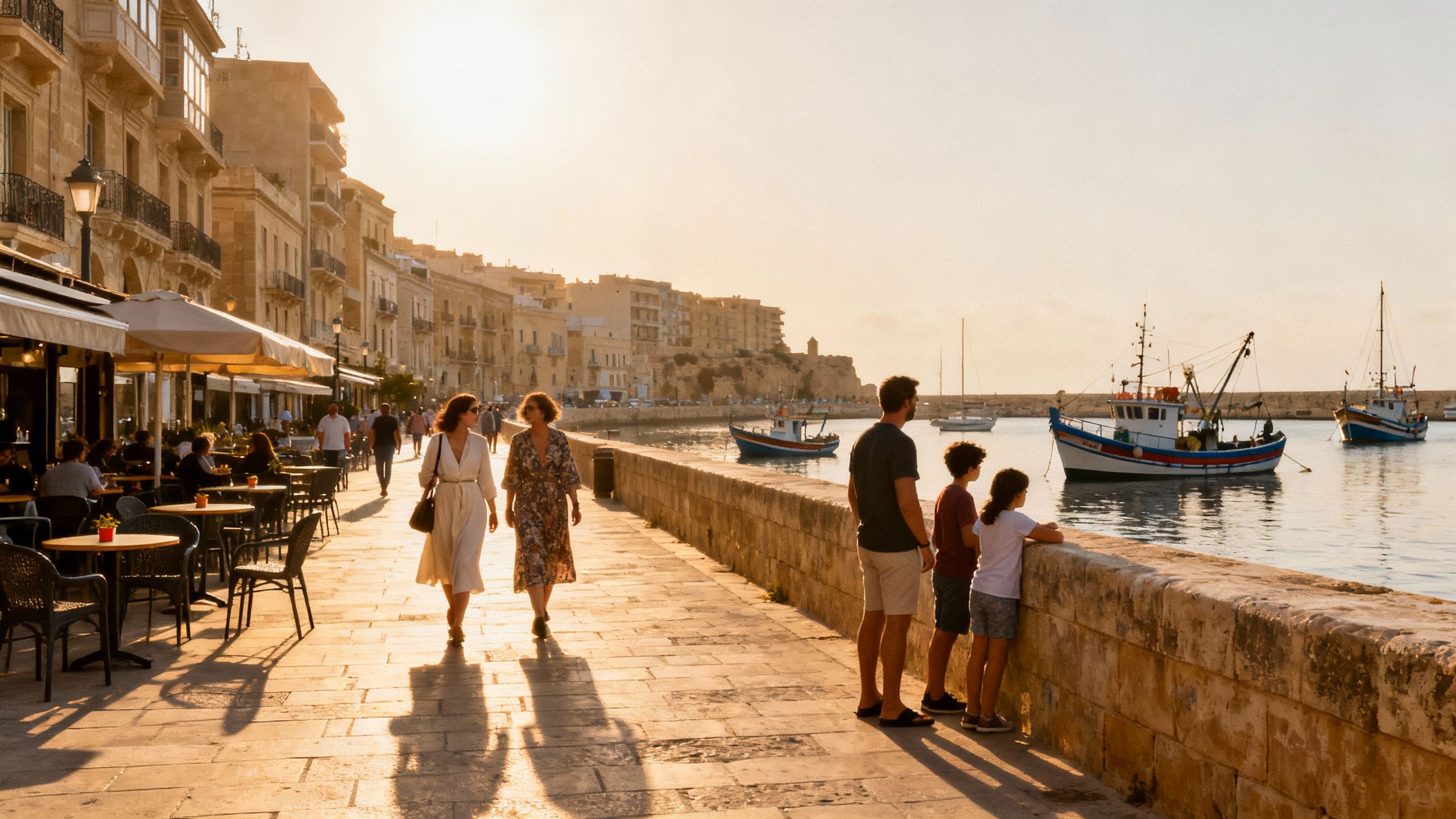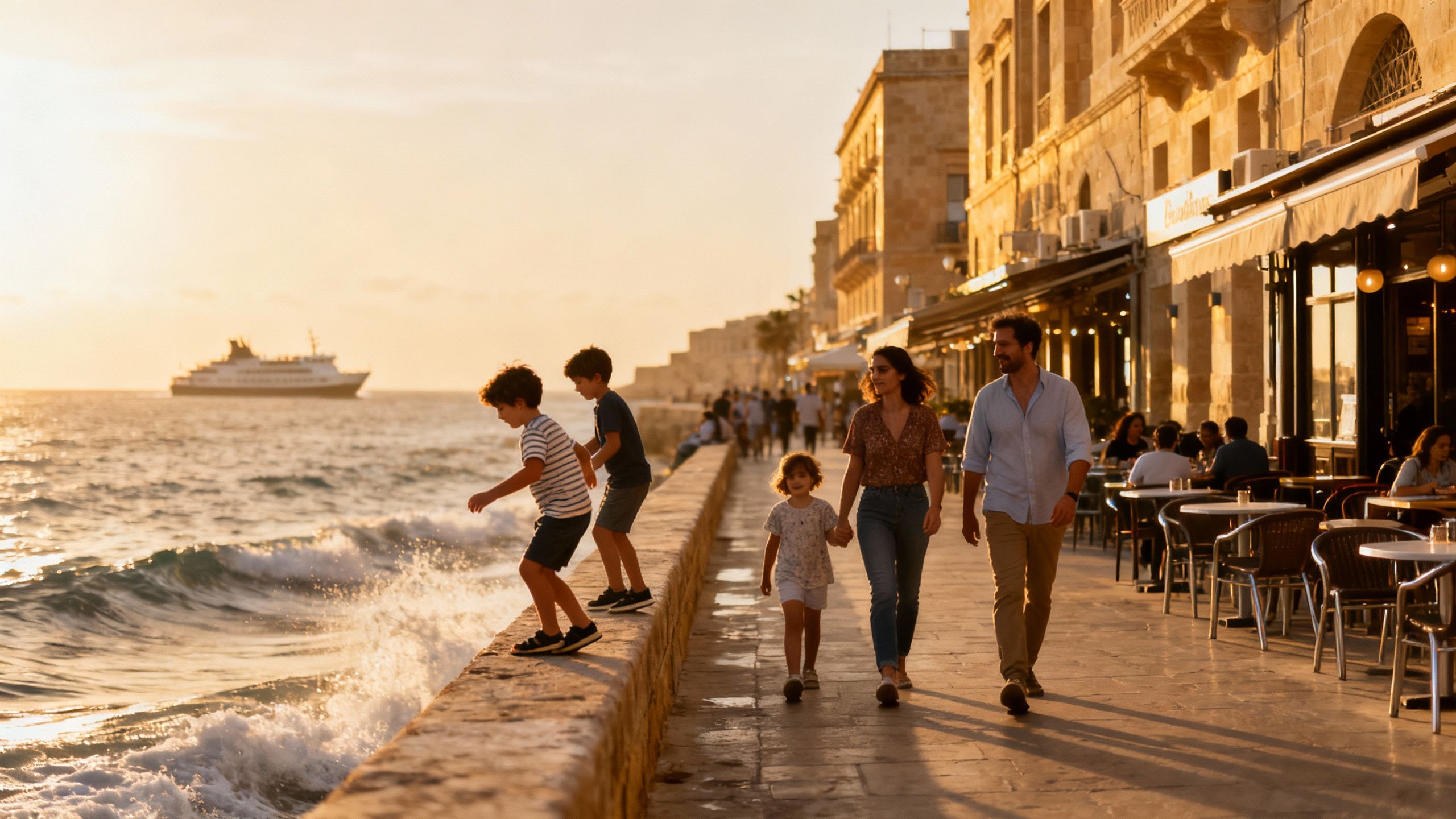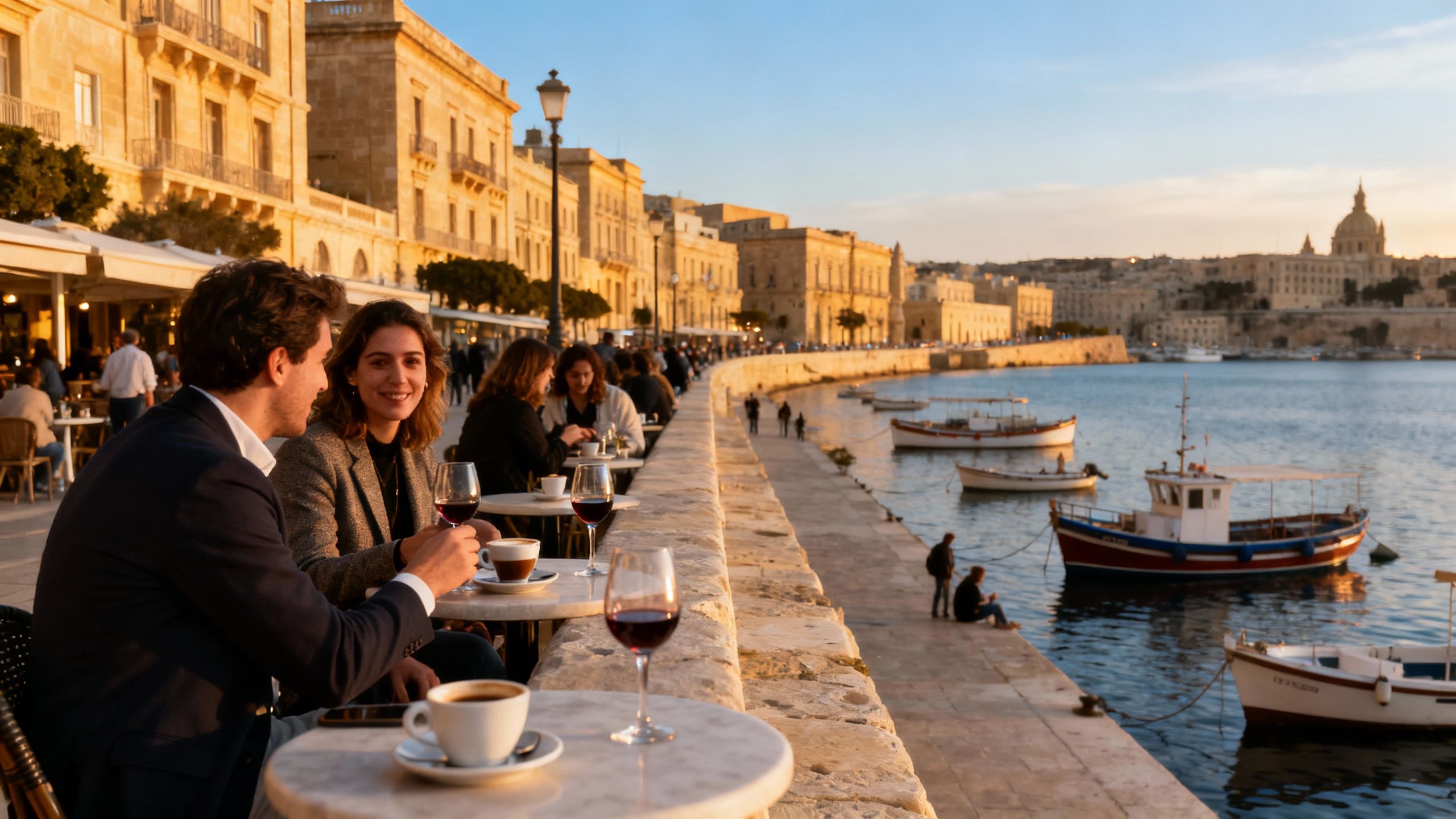The Neighbourhood Malta’s Buyers Overlook (and Why It Pays)
A contrarian look at Malta: how harbour towns and quieter neighbourhoods offer the island’s truest lifestyle and smarter value, backed by recent RPPI data.
Imagine stepping out for a morning espresso on a narrow limestone street in Kalkara, then walking five minutes to a quiet harbour where fishermen mend nets and old cafés open for the day. Malta rewards small, lived-in moments — a weekday rhythm of market stalls, chapel bells, and neighbours stopping to chat — and yet much of the market conversation fixes on Sliema’s skyline or Valletta’s palaces. That focus hides opportunity: charming streets and overlooked districts that offer the island’s authentic rhythm with more favourable value and genuine community.
Living the Maltese Lifestyle

Malta is compact and convivial: daily life takes place at street level, in cafés such as Caffe Cordina in Valletta, past butcher shops on Triq ir-Repubblika and along promenades in Birgu and Sliema. Summers swell with beach life in Għajn Tuffieħa and Mellieħa, while winters are mild and local. The island’s pace favours walks, trusting small trades and a public life shaped by festivals and festa processions more than by anonymous modern development. Recent statistics show property prices continue to rise nationally, a reminder that lifestyle choice and timing matter when buying. (See NSO data.)
Kalkara, Birgu and the South‑Harbour Character
Walk Birgu’s narrow lanes and you see limestone doorways, timber balconies and small piazzas where older Maltese play cards. Kalkara, across the water, has been quietly reborn: restored townhouses, modest new terraces and a harbour life that resists tourist staging. These areas reward buyers who prize lived authenticity — morning markets, family-run restaurants and handy access to Valletta by ferry — while prices remain softer than the central waterfronts.
Sliema and St Julian’s: The Familiar Magnet
Sliema and St Julian’s remain the island’s most visible markets — promenades, cafés, international restaurants and easy services. They suit buyers who want an established expat community and conveniences on the doorstep. Expect higher per‑square‑metre figures in these districts, particularly for renovated apartments with sea views; prime areas are where liquidity and rental demand are strongest.
- Lifestyle highlights: streets, cafés and hidden corners
- Morning espresso at Caffe Cordina (Valletta) and a passeggiata on the Upper Barrakka Gardens.
- Sunday fish market at Marsaxlokk followed by a walk along the boardwalk and quiet harbourfront maisonettes.
- Harbour-side promenades in Birgu and Kalkara with restored townhouses a short ferry from Valletta.
Making the Move: Practical Considerations

Shifting from holiday thinking to ownership means reconciling the life you want with market reality. National data records persistent price appreciation — the RPPI rose notably through 2024–2025 — and recent legal developments around citizenship and residency affect investor sentiment. A considered purchase in Malta combines an appreciation for neighbourhood rhythm with clear attention to local market indicators and legal context.
Property types and how they shape daily life
Maisonettes and traditional townhouses reward those who want internal courtyards, terrace life and historical detail; many have thick stone walls that keep interiors cool. Apartments are efficient and plentiful but vary hugely in finish — a classic Maltese balcony or original floor tiles signals provenance. In Gozo, farmhouses and villas offer space and rural calm; on the main island, terraces and seafront apartments connect directly to promenades and cafés.
Working with local experts who know the lifestyle
A good Maltese agent is less a salesperson and more a local curator: they understand festa calendars, the practicalities of old‑stone maintenance, and which neighbourhoods stay lively year‑round. Seek agencies with demonstrable restoration experience and local networks — solicitors, architects familiar with Part LIG or heritage rules, and property managers who can keep a second home occupied and maintained.
- Steps that blend lifestyle and practical due diligence
- Visit at different times (weekday morning, weekend evening and off‑season) to sense community rhythms before making an offer.
- Commission a conservation‑aware survey for older properties: check stonework, roof slabs, and original timber elements rather than only cosmetic finishes.
- Confirm local utility capacity and any limits on extensions — municipal rules and heritage overlays often dictate what can be altered.
Insider Knowledge: What Expats Wish They’d Known
Expats often arrive enchanted by Valletta’s theatre nights or Mellieħa’s sand but underestimate subtleties: where community forms, which cafés stay open through winter, and which streets experience noise from seasonal tourism. The EU court ruling on Malta’s citizenship programme has shifted the profile of buyers and increased scrutiny; for purchasers, that means a clearer, more transparent market but also renewed attention to genuine local ties and long‑term stewardship.
Language, community and daily integration
English is widely spoken; Maltese persists in family life and festa rituals. Joining a local association, volunteering at a church festa, or frequenting a single café will build reciprocal ties faster than attending open‑house weekends alone. For families, small‑scale neighbourhood life — parks, local schools and after‑school activities — determines where you will thrive more than headline districts.
Long‑term stewardship and resale considerations
Properties with architectural integrity and documented restorations retain value. Look for evidence of sound conservation: original lintels, restored maltese balconies, and professional reports on structural repairs. In a small market like Malta, reputation matters; buyers who commit to maintenance and respectful updates often find better resale prospects and a community that values provenance.
- Red flags to watch for
- Unexplained vacancies in a property’s recent history — may signal legal or maintenance issues.
- Promises of rapid citizenship tied to purchase — recent EU rulings have curtailed historic schemes; treat such claims with caution.
- Lack of documented heritage or planning permissions for modifications in older homes.
If you imagine life in Malta as a series of tactile, small pleasures — an evening walk on a harbour quay, a market basket of fresh produce, a neighbour who knows your coffee order — then buying here should prioritise neighbourhood character over headline addresses. Agents who understand that distinction will help you find homes that feel lived in, not staged.
Next steps that bring the lifestyle into reach
- Schedule short reconnaissance visits in two different seasons to test weather, events and service patterns.
- Engage a local solicitor early to verify title, planning history and any outstanding constraints.
- Ask agents for recent comparable sales in the street (not just the suburb) and for examples of completed restorations they advised on.
Conclusion: Malta rewards patience and local attention. Look beyond the postcard skyline to neighbourhoods where real life is made — Birgu’s harbour lanes, Kalkara’s quiet quays, a townhouse with a sheltered courtyard — and you’ll find value that matches the island’s character. Begin with visits, prioritise conservation‑aware advice, and work with practitioners who value provenance as much as price. The result is not merely a property, but a place to belong.
Norwegian with years in Florence guiding clients across borders. I bridge Oslo and Tuscany, focusing on legal navigation, cultural context, and enduring craftsmanship.


